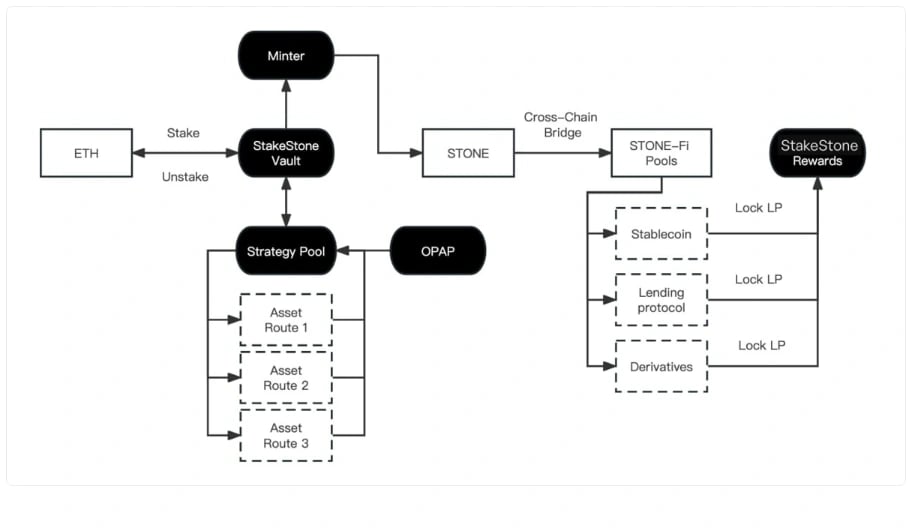위키 구독하기
Share wiki
Bookmark
StakeStone
StakeStone
StakeStone은 적응형 스테이킹 네트워크를 기반으로 유동적인 ETH/BTC를 제공하는 STONE/STONEBTC를 구축하는 옴니체인 유동성 인프라입니다. StakeStone은 주요 스테이킹 풀을 지원하며 향후 리스테이킹과도 호환됩니다. STONE 및 유동적 ETH를 기반으로 멀티체인 유동성 시장을 만들어 STONE 사용자에게 더 많은 사용 사례와 수익 기회를 제공합니다. [1][2]
개요
StakeStone은 OPAP(Optimizing Portfolio and Allocation Proposal)이라는 메커니즘을 통해 유동적 스테이킹을 위한 최초의 분산형 솔루션을 개척합니다. MPC 지갑에 의존하는 기존 방식과 달리 StakeStone은 기본 자산과 수익에 대한 투명성을 제공합니다. 한편, OPAP는 STONE의 기본 자산을 최적화하여 STONE 보유자가 최적화된 스테이킹 수익을 받을 수 있도록 합니다. [6]
LayerZero를 기반으로 하는 STONE은 자산과 가격 모두를 여러 블록체인에서 전송할 수 있는 비리베이스 OFT(Omnichain Fungible Token)입니다. Layer2의 개발자는 추가적인 복잡성 없이 STONE을 통합할 수 있으므로 대량 채택을 위한 접근 가능한 유동적 ETH로 남습니다. [7]
STONE, 유동적 ETH
STONE은 수익 생성 측면에서 Lido의 wstETH와 동일한 메커니즘을 가진 비리베이스 ERC-20 토큰입니다. 비리베이스는 지갑의 STONE 잔액이 증가하지 않음을 의미합니다. 그러나 누적된 ETH 스테이킹 수익으로 인해 ETH에서 STONE의 가치가 증가합니다. [3]
예를 들어, 사용자 A가 100 ETH를 100 STONE으로 예치하고 1년 후 1 STONE의 가치가 1.04 ETH가 되면 사용자는 100 STONE으로 StakeStone에서 104 ETH를 인출할 수 있습니다. [3]
STONE은 또한 Layerzero를 기반으로 하는 옴니체인 펑기블 토큰(OFT)입니다. 이 기능을 통해 STONE을 여러 체인 간에 브리징할 수 있습니다. 또한 StakeStone은 Layerzero의 솔루션을 활용하여 맞춤형 계약을 개발하여 STONE의 크로스체인 호환성을 더욱 향상시킵니다. [3][6]
기술
OPAP
OPAP(Optimizing Portfolio and Allocation Proposal) 메커니즘은 유동적 스테이킹 수익을 최적화하기 위한 최초의 분산형 솔루션입니다. MPC 지갑에 의존하는 기존 방식과 달리 StakeStone은 기본 자산과 수익에 대한 투명성을 제공합니다. [4][5]
OPAP는 STONE의 기본 자산을 최적화하여 STONE 보유자가 자동으로 최적화된 스테이킹 수익을 받을 수 있도록 합니다. [4]
StakeStone Vault
예치, 인출 및 결제 관리
StakeStone Vault는 새로운 결제가 발생할 때까지 계약 내에 예치된 ETH를 유지하는 자금 버퍼링 풀 역할을 하며, 그 시점에 기본 전략 풀에 배포됩니다. [5]
Minter
민팅 및 소각 of STONE
Minter 기능은 STONE 토큰 민팅을 기본 자산과 분리합니다. 이 분리는 기본 자산과 발행된 STONE 토큰의 유통을 독립적으로 조정하여 더 높은 수준의 토큰 안정성을 보장합니다. [5]
Strategy Pool
자산 수익 경로 화이트리스트
Strategy Pool은 OPAP에 의해 관리되는 화이트리스트 메커니즘을 채택하여 스테이킹 풀, 리스테이킹 프로토콜 등과 같은 높은 수준의 자산 호환성을 보여줍니다. 동시에 자산 위험은 각 개별 전략 경로 내에서 격리되어 위험의 교차 오염을 방지합니다. [5]

잘못된 내용이 있나요?
